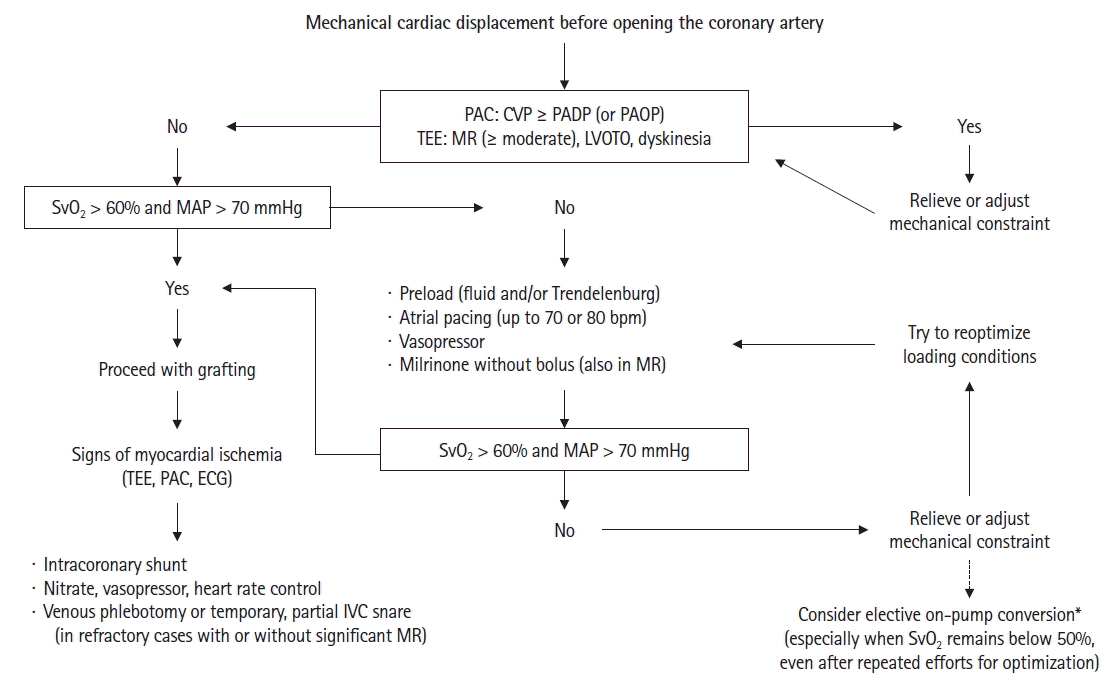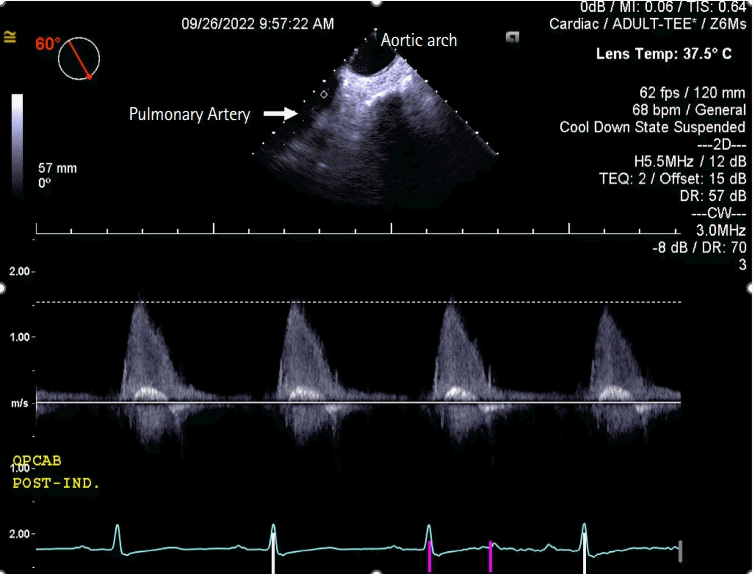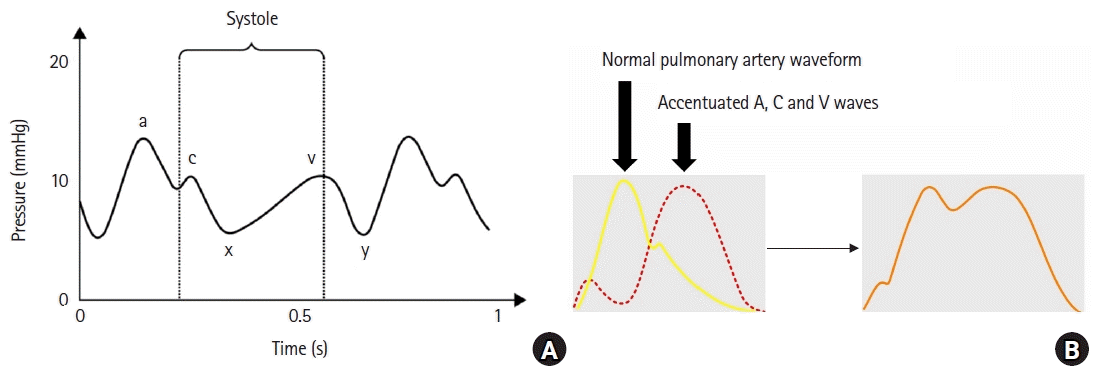1. Puskas JD, Martin J, Cheng DC, Benussi S, Bonatti JO, Diegeler A, et al. ISMICS consensus conference and statements of randomized controlled trials of off-pump versus conventional coronary artery bypass surgery. Innovations (Phila). 2015; 10:219–29.
2. Benedetto U, Angelini GD, Caputo M, Feldman DN, Kim LK, Lau C, et al. Off- vs. on-pump coronary artery bypass graft surgery on hospital outcomes in 134,117 octogenarians. J Thorac Dis. 2017; 9:5085–92.
3. Ueki C, Miyata H, Motomura N, Sakata R, Sakaguchi G, Akimoto T, et al. Off-pump technique reduces surgical mortality after elective coronary artery bypass grafting in patients with preoperative renal failure. J Thorac Cardiovasc Surg. 2018; 156:976–83.
4. Keeling WB, Williams ML, Slaughter MS, Zhao Y, Puskas JD. Off-pump and on-pump coronary revascularization in patients with low ejection fraction: a report from the society of thoracic surgeons national database. Ann Thorac Surg. 2013; 96:83–8.
5. Shroyer AL, Grover FL, Hattler B, Collins JF, McDonald GO, Kozora E, et al. On-pump versus off-pump coronary-artery bypass surgery. N Engl J Med. 2009; 361:1827–37.
6. Lamy A, Devereaux PJ, Prabhakaran D, Taggart DP, Hu S, Paolasso E, et al. Off-pump or on-pump coronary-artery bypass grafting at 30 days. N Engl J Med. 2012; 366:1489–97.
7. Diegeler A, Börgermann J, Kappert U, Breuer M, Böning A, Ursulescu A, et al. Off-pump versus on-pump coronary-artery bypass grafting in elderly patients. N Engl J Med. 2013; 368:1189–98.
8. Mathison M, Edgerton JR, Horswell JL, Akin JJ, Mack MJ. Analysis of hemodynamic changes during beating heart surgical procedures. Ann Thorac Surg. 2000; 70:1355–60.
9. Lee K, Kim KS, Park JK, Choi JH, Kwak YL, Shim JK. Impact of transient decrease in mixed venous oxygen saturation on prognosis in off-pump coronary artery bypass surgery: a retrospective cohort study. Korean J Anesthesiol. 2023; 76:107–15.
10. Puskas JD, Gaudino M, Taggart DP. Experience is crucial in off-pump coronary artery bypass grafting. Circulation. 2019; 139:1872–5.
11. Chassot PG, van der Linden P, Zaugg M, Mueller XM, Spahn DR. Off-pump coronary artery bypass surgery: physiology and anaesthetic management. Br J Anaesth. 2004; 92:400–13.
12. George SJ, Al-Ruzzeh S, Amrani M. Mitral annulus distortion during beating heart surgery: a potential cause for hemodynamic disturbance--a three-dimensional echocardiography reconstruction study. Ann Thorac Surg. 2002; 73:1424–30.
13. Nierich AP, Diephuis J, Jansen EW, Borst C, Knape JT. Heart displacement during off-pump CABG: how well is it tolerated? Ann Thorac Surg. 2000; 70:466–72.
14. Kwak YL, Oh YJ, Jung SM, Yoo KJ, Lee JH, Hong YW. Change in right ventricular function during off-pump coronary artery bypass graft surgery. Eur J Cardiothorac Surg. 2004; 25:572–7.
15. Yip GW, Zhang Y, Tan PY, Wang M, Ho PY, Brodin LA, et al. Left ventricular long-axis changes in early diastole and systole: impact of systolic function on diastole. Clin Sci (Lond). 2002; 102:515–22.
16. Jin R, Hiratzka LF, Grunkemeier GL, Krause A, Page US 3rd. Aborted off-pump coronary artery bypass patients have much worse outcomes than on-pump or successful off-pump patients. Circulation. 2005; 112(9 Suppl):I332–7.
17. Vassiliades TA Jr, Nielsen JL, Lonquist JL. Hemodynamic collapse during off-pump coronary artery bypass grafting. Ann Thorac Surg. 2002; 73:1874–9.
18. Chowdhury R, White D, Kilgo P, Puskas JD, Thourani VH, Chen EP, et al. Risk factors for conversion to cardiopulmonary bypass during off-pump coronary artery bypass surgery. Ann Thorac Surg. 2012; 93:1936–41.
19. Gaudino M, Benedetto U, Bakaeen F, Rahouma M, Tam DY, Abouarab A, et al. Off-versus on-pump coronary surgery and the effect of follow-up length and surgeons' experience: a meta-analysis. J Am Heart Assoc. 2018; 7:e010034.
20. Balacumaraswami L, Muir AD, Kirmani BH, Taggart DP. Off-pump surgeons' experience is paramount to delivering high-quality CABG outcomes: but what constitutes experience? J Am Coll Cardiol. 2019; 73:737–8.
21. Couture P, Denault A, Limoges P, Sheridan P, Babin D, Cartier R. Mechanisms of hemodynamic changes during off-pump coronary artery bypass surgery. Can J Anaesth. 2002; 49:835–49.
22. Li Z, Amsterdam EA, Danielsen B, Hoegh H, Young JN, Armstrong EJ. Intraoperative conversion from off-pump to on-pump coronary artery bypass is associated with increased 30-day hospital readmission. Ann Thorac Surg. 2014; 98:16–22.
23. Topkara VK, Cheema FH, Kesavaramanujam S, Mercando ML, Cheema AF, Namerow PB, et al. Coronary artery bypass grafting in patients with low ejection fraction. Circulation. 2005; 112(9 Suppl):I344–50.
24. Cikes M, Solomon SD. Beyond ejection fraction: an integrative approach for assessment of cardiac structure and function in heart failure. Eur Heart J. 2016; 37:1642–50.
25. Matyal R, Skubas NJ, Shernan SK, Mahmood F. Perioperative assessment of diastolic dysfunction. Anesth Analg. 2011; 113:449–72.
26. Ommen SR, Nishimura RA, Appleton CP, Miller FA, Oh JK, Redfield MM, et al. Clinical utility of Doppler echocardiography and tissue Doppler imaging in the estimation of left ventricular filling pressures: a comparative simultaneous Doppler-catheterization study. Circulation. 2000; 102:1788–94.
27. Hillis GS, Moller JE, Pellikka PA, Gersh BJ, Wright RS, Ommen SR, et al. Noninvasive estimation of left ventricular filling pressure by E/e’ is a powerful predictor of survival after acute myocardial infarction. J Am Coll Cardiol. 2004; 43:360–7.
28. Shim JK, Choi YS, Chun DH, Hong SW, Kim DH, Kwak YL. Relationship between echocardiographic index of ventricular filling pressure and intraoperative haemodynamic changes during off-pump coronary bypass surgery. Br J Anaesth. 2009; 102:316–21.
29. Jun NH, Shim JK, Kim JC, Kwak YL. Prognostic value of a tissue Doppler-derived index of left ventricular filling pressure on composite morbidity after off-pump coronary artery bypass surgery. Br J Anaesth. 2011; 107:519–24.
30. Lee EH, Yun SC, Chin JH, Choi DK, Son HJ, Kim WC, et al. Prognostic implications of preoperative E/e’ ratio in patients with off-pump coronary artery surgery. Anesthesiology. 2012; 116:362–71.
31. Kwak YL. Reduction of ischemia during off-pump coronary artery bypass graft surgery. J Cardiothorac Vasc Anesth. 2005; 19:667–77.
32. Bianco V, Kilic A, Gelzinis T, Gleason TG, Navid F, Rauso L, et al. Off-pump coronary artery bypass grafting: closing the communication gap across the ether screen. J Cardiothorac Vasc Anesth. 2020; 34:258–66.
33. Mishra M, Malhotra R, Mishra A, Meharwal ZS, Trehan N. Hemodynamic changes during displacement of the beating heart using epicardial stabilization for off-pump coronary artery bypass graft surgery. J Cardiothorac Vasc Anesth. 2002; 16:685–90.
34. Gründeman PF, Borst C, van Herwaarden JA, Verlaan CW, Jansen EW. Vertical displacement of the beating heart by the octopus tissue stabilizer: influence on coronary flow. Ann Thorac Surg. 1998; 65:1348–52.
35. Jarry S, Couture EJ, Falih J, Lebon JS, Ayoub C, Rochon A, et al. New development in brain monitoring for cardiac surgery. Can J Cardiol. 2023; 39:229–32.
36. De Backer D, Biston P, Devriendt J, Madl C, Chochrad D, Aldecoa C, et al. Comparison of dopamine and norepinephrine in the treatment of shock. N Engl J Med. 2010; 362:779–89.
37. Sakr Y, Reinhart K, Vincent JL, Sprung CL, Moreno R, Ranieri VM, et al. Does dopamine administration in shock influence outcome? Results of the Sepsis Occurrence in Acutely Ill Patients (SOAP) study. Crit Care Med. 2006; 34:589–97.
38. Guarracino F, Habicher M, Treskatsch S, Sander M, Szekely A, Paternoster G, et al. Vasopressor therapy in cardiac surgery-an experts’ consensus statement. J Cardiothorac Vasc Anesth. 2021; 35:1018–29.
39. Busse LW, Barker N, Petersen C. Vasoplegic syndrome following cardiothoracic surgery-review of pathophysiology and update of treatment options. Crit Care. 2020; 24:36.
40. Oh YJ, Lee JH, Nam SB, Shim JK, Song JH, Kwak YL. Effects of chronic angiotensin II receptor antagonist and angiotensin-converting enzyme inhibitor treatments on neurohormonal levels and haemodynamics during cardiopulmonary bypass. Br J Anaesth. 2006; 97:792–8.
41. Morales DL, Garrido MJ, Madigan JD, Helman DN, Faber J, Williams MR, et al. A double-blind randomized trial: prophylactic vasopressin reduces hypotension after cardiopulmonary bypass. Ann Thorac Surg. 2003; 75:926–30.
42. Jeon Y, Ryu JH, Lim YJ, Kim CS, Bahk JH, Yoon SZ, et al. Comparative hemodynamic effects of vasopressin and norepinephrine after milrinone-induced hypotension in off-pump coronary artery bypass surgical patients. Eur J Cardiothorac Surg. 2006; 29:952–6.
43. Hussain A, Bennett R, Haqzad Y, Qadri S, Chaudhry M, Cowen M, et al. The differential effects of systemic vasoconstrictors on human pulmonary artery tension. Eur J Cardiothorac Surg. 2017; 51:880–6.
44. Neuhäuser C, Müller M, Welters I, Scholz S, Kwapisz MM. Effect of isoflurane on echocardiographic left-ventricular relaxation indices in patients with diastolic dysfunction due to concentric hypertrophy and ischemic heart disease. J Cardiothorac Vasc Anesth. 2006; 20:509–14.
45. Ruffolo RR Jr. The pharmacology of dobutamine. Am J Med Sci. 1987; 294:244–8.
46. Tanimoto M, Pai RG, Jintapakorn W, Shah PM. Dobutamine stress echocardiography for the diagnosis and management of coronary artery disease. Clin Cardiol. 1995; 18:252–60.
47. Baruch L, Patacsil P, Hameed A, Pina I, Loh E. Pharmacodynamic effects of milrinone with and without a bolus loading infusion. Am Heart J. 2001; 141:266–73.
48. Monrad ES, Baim DS, Smith HS, Lanoue AS. Milrinone, dobutamine, and nitroprusside: comparative effects on hemodynamics and myocardial energetics in patients with severe congestive heart failure. Circulation. 1986; 73:III168–74.
49. Omae T, Kakihana Y, Mastunaga A, Tsuneyoshi I, Kawasaki K, Kanmura Y, et al. Hemodynamic changes during off-pump coronary artery bypass anastomosis in patients with coexisting mitral regurgitation: improvement with milrinone. Anesth Analg. 2005; 101:2–8.
50. Spodick DH. The normal and diseased pericardium: current concepts of pericardial physiology, diagnosis and treatment. J Am Coll Cardiol. 1983; 1:240–51.
51. Piot C, LeMaire SA, Albat B, Seguin J, Nargeot J, Richard S. High frequency-induced upregulation of human cardiac calcium currents. Circulation. 1996; 93:120–8.
52. Velissaris T, Jonas MM, Ohri SK. Hemodynamic advantages of right heart decompression during off-pump surgery. Asian Cardiovasc Thorac Ann. 2010; 18:17–21.
53. Elmi-Sarabi M, Jarry S, Couture EJ, Haddad F, Cogan J, Sweatt AJ, et al. Pulmonary vasodilator response of combined inhaled epoprostenol and inhaled milrinone in cardiac surgical patients. Anesth Analg. 2023; 136:282–94.
54. Beaubien-Souligny W, Denault AY. Real-time assessment of renal venous flow by transesophageal echography during cardiac surgery. A A Pract. 2019; 12:30–2.
55. Kearns MJ, Walley KR. Tamponade: hemodynamic and echocardiographic diagnosis. Chest. 2018; 153:1266–75.
56. Falicov RE, Resnekov L. Relationship of the pulmonary artery end-diastolic pressure to the left ventricular end-diastolic and mean filling pressures in patients with and without left ventricular dysfunction. Circulation. 1970; 42:65–73.
57. Holm J, Håkanson E, Vánky F, Svedjeholm R. Mixed venous oxygen saturation predicts short- and long-term outcome after coronary artery bypass grafting surgery: a retrospective cohort analysis. Br J Anaesth. 2011; 107:344–50.
58. Kasnitz P, Druger GL, Yorra F, Simmons DH. Mixed venous oxygen tension and hyperlactatemia. Survival in severe cardiopulmonary disease. JAMA. 1976; 236:570–4.
59. Kaplan JA. Kaplan’s cardiac anesthesia. 7th ed. Philadelphia: Elsevier Saunders;2016. p. 1295.
60. Salmasi V, Maheshwari K, Yang D, Mascha EJ, Singh A, Sessler DI, et al. Relationship between intraoperative hypotension, defined by either reduction from baseline or absolute thresholds, and acute kidney and myocardial injury after noncardiac surgery: a retrospective cohort analysis. Anesthesiology. 2017; 126:47–65.
61. Sessler DI, Bloomstone JA, Aronson S, Berry C, Gan TJ, Kellum JA, et al. Perioperative Quality Initiative consensus statement on intraoperative blood pressure, risk and outcomes for elective surgery. Br J Anaesth. 2019; 122:563–74.
62. Reinhart K, Bloos F, König F, Bredle D, Hannemann L. Reversible decrease of oxygen consumption by hyperoxia. Chest. 1991; 99:690–4.
63. Calzia E, Radermacher P, Matejovic M. Splanchnic resuscitation revisited: combining hyperoxia and hypertonic saline during early goal-directed treatment. Crit Care Med. 2006; 34:2858–60.
64. Nam K, Kim HB, Kwak YL, Jeong YH, Ju JW, Bae J, et al. Effect of changes in inspired oxygen fraction on oxygen delivery during cardiac surgery: a substudy of the CARROT trial. Sci Rep. 2021; 11:17862.
65. Guensch DP, Fischer K, Yamaji K, Luescher S, Ueki Y, Jung B, et al. Effect of hyperoxia on myocardial oxygenation and function in patients with stable multivessel coronary artery disease. J Am Heart Assoc. 2020; 9:e014739.
66. Hahn RT, Abraham T, Adams MS, Bruce CJ, Glas KE, Lang RM, et al. Guidelines for performing a comprehensive transesophageal echocardiographic examination: recommendations from the American Society of Echocardiography and the Society of Cardiovascular Anesthesiologists. J Am Soc Echocardiogr. 2013; 26:921–64.
67. Doyle T, Troup PJ, Wann LS. Mid-diastolic opening of the pulmonary valve after right ventricular infarction. J Am Coll Cardiol. 1985; 5:366–8.
68. Sekiya N, Ryomoto M, Tanaka H, Yamamura M, Yamashita K, Yajima S, et al. Graft traction resolved left ventricular outflow tract obstruction. Ann Thorac Surg. 2021; 111:e415–7.
69. Denault A, Couture EJ, De Medicis E, Shim JK, Mazzeffi M, Henderson RA, et al. Perioperative Doppler ultrasound assessment of portal vein flow pulsatility in high-risk cardiac surgery patients: a multicentre prospective cohort study. Br J Anaesth. 2022; 129:659–69.
70. Cohen M, Sherman W, Rentrop KP, Gorlin R. Determinants of collateral filling observed during sudden controlled coronary artery occlusion in human subjects. J Am Coll Cardiol. 1989; 13:297–303.
71. Kaplan JA, Wells PH. Early diagnosis of myocardial ischemia using the pulmonary arterial catheter. Anesth Analg. 1981; 60:789–93.
72. van Daele ME, Sutherland GR, Mitchell MM, Fraser AG, Prakash O, Rulf EN, et al. Do changes in pulmonary capillary wedge pressure adequately reflect myocardial ischemia during anesthesia? A correlative preoperative hemodynamic, electrocardiographic, and transesophageal echocardiographic study. Circulation. 1990; 81:865–71.
73. Futami C, Tanuma K, Tanuma Y, Saito T. The arterial blood supply of the conducting system in normal human hearts. Surg Radiol Anat. 2003; 25:42–9.
74. Bagdonas AA, Stuckey JH, Piera J, Amer NS, Hoffman BF. Effects of ischemia and hypoxia on the specialized conducting system of the canine heart. Am Heart J. 1961; 61:206–18.
75. Shim JK, Choi YS, Yoo KJ, Kwak YL. Carbon dioxide embolism induced right coronary artery ischaemia during off-pump obtuse marginalis artery grafting. Eur J Cardiothorac Surg. 2009; 36:598–9.
76. Lee CS, Yoon YS, Shim JK, Lim HK. Successful resuscitation of cardiac arrest caused by CO2 embolism with intra-aortic injection of epinephrine during off-pump coronary bypass surgery -a case report-. Korean J Anesthesiol. 2013; 65:562–4.
77. Couture P, Denault AY, Sheridan P, Williams S, Cartier R. Partial inferior vena cava snaring to control ischemic left ventricular dysfunction. Can J Anaesth. 2003; 50:404–10.





 PDF
PDF Citation
Citation Print
Print






 XML Download
XML Download